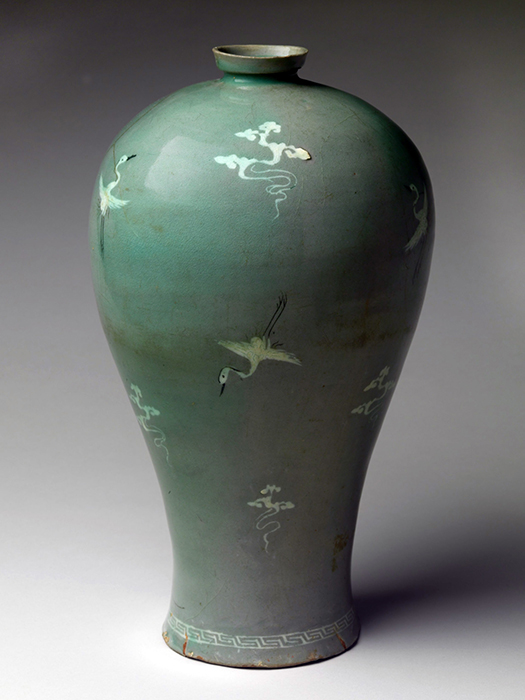12th Century Celadon Vase
Episode 26: Korea – The Koryo
Foundations of Eastern Civilization
Dr Craig Benjamin (2013)
Film Review
King Taejo, founder of the Koryo[1] Dynasty (935-1392 AD), attempted to unite the country’s warring nobles by inviting them to serve at court. The fourth Koryo king Kwangjong (925-975 AD) would crush rebellious nobles via the following measures:
- Passing the Slave Review Act, reducing the economic and military power of many nobles by freeing their slaves.
- Introducing a genuine Confucian civil service exam system open to all classes, and not just the nobility.
- Introducing a brutal purge of remaining Castle Lords (see Ancient Korean History: Consolidation of Class Society), enabling Koryo to assert royal authority over the entire peninsula.
From the Koryo capitol Kaisong, Kuangjiong set up an extremely complex provincial administration that divided power between government ministers and local administrators.
Under the Koryo Dynasty, Zen became the predominant form of Korean Buddhism. Along with Buddhism, Korea also adopted geomancy (aka Feng Sui) from China. The latter incorporates auspicious natural features planning public buildings, temples tombs and private homes the elites.
The dynasty is is also known for Celadon, distinctive Korean ceramic dishes and ornaments.
in 792 AD, Koryo established a national university to train administrators, doctors, lawyers and accountants. In the 12th century, King Igiong (1122-1146 AD) would set up state schools to educate children. He also also enacted land reform laws. Under the Koryo Dynasty, all land technically belonged to the King although aristocrats could pass their land grants to their heirs. Since Koryo had no Equal Field system like China (enabling emperors to grant land to free-born peasants), Koryo peasants could farm on public land if they paid 25% of their crop to the king. Farmers on private nobles’ land paid 50% to the landowner.
Low-born peasants were required to live in special districts and perform whatever tasks the government assigned them (including farming, mining, silk weaving, and paper making). Government-owned slaves performed duties in the palace and publicly owned buildings.[2] There was also an outcast group (similar to India’s untouchables) consisting of butchers, wicker workers and kisaeng (female “comfort workers”).
King Kuangjiong and his successors continued to expand Koryo into northern regions formerly controlled by the Koguyu. This brought Koryo into conflict with the Khitan steppes nomads, who had conquered the state of Parhae (see Ancient Korean History: Consolidation of Class Society/). In 1010 AD 400,000 Khitan nomads crossed the frozen Yellow River and sacked and pillaged the Koryo capitol Kaesang.
Jurchen nomads from Manchuria also repeatedly attacked Koryo, despite extensive boundary walls constructed to keep them out.
After numerous of attacks on the Koryo throne, in 1170 AD a military coup established a dictatorship under whom the last Koryo kings served merely as figureheads.
In 1193, two massive peasant revolts occurred, resulting in the slaughter of 7,000 peasants, and in 1198, the entire slave population of Kaesang revolted.
The Mongols invaded the peninsula in 1231 AD[3], placing some regions under direct military rule and simply demanding tribute (gold, silver, grain falcons and young women) from others. This presented many Koryo peasants with the burden of paying levies both to the Mongols and their own government.
Between 1351-74 AD, the 31st ruler of Koryo Kongmin finally drove the the Mongols out of Koryo[4] and, with the help of Ming Dynasty officials he recruited to his government, ousted the nobles who collaborated with them. Kongmin is also known for enacting the first land reform laws redistributing land to peasant farmers.
The Koryo dynasty fell in 1392, after Kongmin’s assassination led to significant peasant unrest and Japanese pirates disrupted Koryo’s lucrative trade with China. The Choson Dynasty that followed survived to 1910.
[1] Origin of modern country name Korea.
[2] Slave status was hereditary and slaves could be bought and sold.
[3] The Mongols had just established the Yuan dynasty in China.
[4] Just as the Ming Dynasty was expelling them from China.
Film can be viewed free with a library card on Kanopy
https://www.kanopy.com/en/pukeariki/watch/video/5808608/5808661

